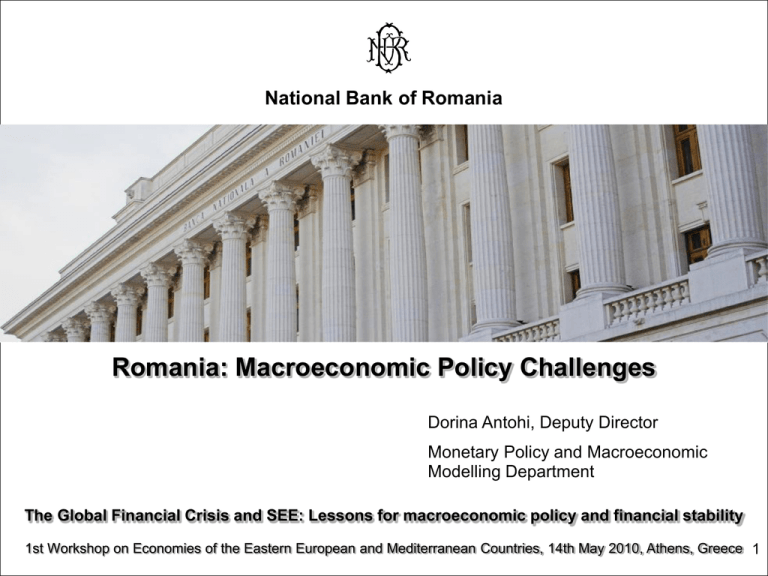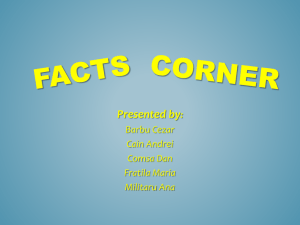National Bank of Romania
advertisement

Titlu slide National Bank of Romania Romania: Macroeconomic Policy Challenges Dorina Antohi, Deputy Director Monetary Policy and Macroeconomic Modelling Department The Global Financial Crisis and SEE: Lessons for macroeconomic policy and financial stability 1st Workshop on Economies of the Eastern EuropeanBank and Mediterranean Countries, 14th May 2010, Athens, Greece 1 National of Romania Romania – basic info Titlu slide • Location: Central & Eastern Europe • European Union member since 1 January 2007 • Population: 21.5 million inhabitants as of 1 January 2009 • Currency: Romanian leu • Small open economy • GDP per capita: 12000 (pps, 2008) – 25100 EU 27 National Bank of Romania 2 Main structural and institutional characteristics of the economy Titlu slide • • • Degree of openness: 73.9% (2008) Share of private sector in GDP: 70.8% (2008) Structure of GDP by sectors (2008) Net taxes 10.6 Agriculture 6.5 Industry 22.9 Construction 10.5 Services 49.5 • • Banking system: majority foreign owned (88.3 % of total assets, 2008) Monetary policy strategy and exchange rate regime: since August 2005, inflation targeting and managed float exchange rate regime National Bank of Romania 3 Main macroeconomic developments during pre-crisis period Titlu slide • Romania exhibited high annual economic growth between 20012008: catching-up, increased capital inflows due to improved risk perception (EU accession, NATO membership), favourable external context, speeded-up pace of economic and financial integration, increased productivity, substantial credit flows, consumption smoothing • After 2005-6: increasing signs of overheating, emergence and subsequent aggravation of macroeconomic imbalances (persistent excess of aggregate demand, widening external deficits), also on account of increased pro-cyclicality of fiscal and income policies National Bank of Romania 4 Titlu slide 15 10 8.5 7.9 7.3 5 6.3 5.7 5.2 5.1 4.2 2.4 0 -3.3 -3.7 -5.5 -5 -5.8 -8.4 -8.6 Annual GDP gowth -10 -10.4 -11.6 Current account deficit (% in GDP)* -13.4 Real net wage** -15 2000 2001 2002 2003 2004 2005 2006 2007 2008 Source: NIS, NBR * Starting 2003, including reinvested earnings ** Deflated by CPI National Bank of Romania 5 Trade Balance 5,500 5,000 4,500 4,000 3,500 3,000 2,500 2,000 1,500 1,000 500 0 -500 -1,000 -1,500 -2,000 -2,500 Titlu slide (monthly data) EUR million EUR million exports fob imports fob trade balance 2000 2001 2002 2003 2004 2005 2006 2007 2008 5,500 5,000 4,500 4,000 3,500 3,000 2,500 2,000 1,500 1,000 500 0 -500 -1,000 -1,500 -2,000 -2,500 2009 In Jan.- Feb. 2010, yoy growth of exports and imports was 21.8% and 6.2% respectively. Source: National Institute of Statistics National Bank of Romania 6 Titlu slide Budget deficit ESA'95, % of GDP -1.2 -1.2 -1.5 -2.0 -2.2 -2.5 -3.5 -4.7 -5.4 2000 2001 2002 2003 2004 2005 2006 2007 2008 Source: EUROSTAT National Bank of Romania 7 Titlu slide Public debt ESA'95, % of GDP 25.7 24.9 22.5 21.5 18.7 15.8 2000 2001 2002 2003 2004 2005 12.4 12.6 2006 2007 13.3 2008 Source: EUROSTAT National Bank of Romania 8 Titlu slide Credit to private sector according to type of currency - annual growth rates, real terms 120 Total 100 Denominated in fx 80 Denominated in lei 60 40 20 0 -20 -40 Sep-08 May-08 Jan-08 Sep-07 May-07 Jan-07 Sep-06 May-06 Jan-06 Sep-05 May-05 Jan-05 Sep-04 May-04 Jan-04 Sep-03 May-03 Jan-03 Sep-02 May-02 Jan-02 Sep-01 May-01 Jan-01 Sep-00 May-00 Jan-00 -60 Source: NBR National Bank of Romania 9 Titlu slide Credit to private sector according to type of clients - annual growth rates, real terms 250 200 Total Households 150 Companies 100 50 0 -50 Sep-08 May-08 Jan-08 Sep-07 May-07 Jan-07 Sep-06 May-06 Jan-06 Sep-05 May-05 Jan-05 Sep-04 May-04 Jan-04 Sep-03 May-03 Jan-03 Sep-02 May-02 Jan-02 Sep-01 May-01 Jan-01 Sep-00 May-00 Jan-00 -100 Source: NBR National Bank of Romania 10 Financial depth Titlu slide 45 40 M3/GDP 35 Credit to private sector/GDP 30 25 20 15 10 5 0 2000 2001 2002 2003 2004 2005 2006 2007 2008 Source: NBR, NIS National Bank of Romania 11 Titlu slide External debt on maturities and FDI EUR million 80000 Short term debt 70000 Medium and long term debt 60000 Foreign direct investment 50000 40000 30000 20000 10000 0 2000 2001 2002 2003 2004 2005 2006 2007 2008 Source: NBR National Bank of Romania 12 Titlu slide External debt by institutional sectors EUR million 80000 70000 60000 50000 40000 30000 20000 10000 0 2000 2001 2002 2003 Government 2004 2005 Banks 2006 2007 2008 Non-banks Source: NBR National Bank of Romania 13 ... together with: Titlu slide Up to mid-2007: • continued nominal appreciation of the RON, with the exchange rate reaching an unsustainable level (in the first part of 2007); increased risk to monetary and financial stability (given the large share of foreign-currency-denominated loans and liabilities in banks’ balance sheets), induced by a potential relatively sharp subsequent correction of the exchange rate • ongoing disinflation process initiated in 2000 Since second half of 2007 (following the onset of global financial market turbulences): • starting and steepening of RON corrective depreciation • pick-up in inflation, also owing to the occurrence of both domestic and external shocks (the decline of agricultural output following the severe drought, the surge of agri-food and oil prices on external markets) • worsening of inflationary expectations, due to the prospects of a fiscal policy easing and a continued lax income policy in 2008, a period with a busy election schedule National Bank of Romania 14 Titlu slide Inflation and RON/EUR exchange rate % 19 % 25 20 17 15 15 10 13 5 Annual CPI 11 0 9 -5 7 -10 5 -15 RON/EUR (annual change, -apprec./+deprec., rhs) Oct-08 Jul-08 Apr-08 Jan-08 Oct-07 Jul-07 Apr-07 Jan-07 Oct-06 Jul-06 Apr-06 Jan-06 Oct-05 Jul-05 Apr-05 Jan-05 Oct-04 Jul-04 Apr-04 Jan-04 Oct-03 Jul-03 Apr-03 -20 Jan-03 3 Source: NBR, NIS National Bank of Romania 15 Complicated context of monetary policy implementation Titlu slide • • • Implementation of IT focused on ensuring compliance with sustainable progress of disinflation along medium-term path described by announced annual inflation targets, while remaining mindful of not exacerbating existing macroeconomic vulnerabilities or creating financial stability problems whose effects might compromise durability of secured disinflation gains Continuous focus on slowing down speed of growth of both leu and foreign-exchange credit (for macro as well as financial stability reasons), using all available policy tools (interest rate policy, management of liquidity conditions in the money market, reserve requirements mechanism, LTV, loan-to-income limits for households, fx exposure limits to unhedged borrowers, higher coefficients in stress tests for exposures to non-euro credit) Permanent message on need for maintaining consistency of the macroeconomic policy mix (particularly avoiding pro-cyclicality of fiscal and wage policies) National Bank of Romania 16 Inflation Rate 50 Titlu slide percent 45.7 45 40 target (Dec./Dec.) 40.7 actual (12-month average) 35 34.5 30 30.3 actual (Dec./Dec.) 25 22.5 20 17.8 15 15.3 14.1 11.9 10 9.3 5 0 27 25 22 14 9 2000 2001 2002 2003 2004 9.0 8.6 6.6 7.5 ±1pp 4.87 5 ±1pp 6.57 7.8 4.8 6.30 4 ±1pp 3.8 ±1pp 5.6 4.74 3.5 ±1pp 3.5 ±1pp 3,0 ±1pp 2005 2006 2007 2008 2009 2010 2011 (Mar. 2009-Feb. 2010)/(Mar. 2008-Feb. 2009): 5.3% February 2010 (yoy): 4.49% Source: National Institute of Statistics, National Bank of Romania National Bank of Romania 17 Titlu slide Inflation rate and changes in administered and volatile prices annual percentage change 40 Inflation rate 30 Volatile prices* Administered prices 20 10 0 Oct-08 Jul-08 Apr-08 Jan-08 Oct-07 Jul-07 Apr-07 Jan-07 Oct-06 Jul-06 Apr-06 Jan-06 Oct-05 Jul-05 Apr-05 Jan-05 Oct-04 Jul-04 Apr-04 Jan-04 Oct-03 Jul-03 Apr-03 Jan-03 -10 * products with volatile prices: vegetables, fruit, eggs, fuels Source: NIS, NBR calculations National Bank of Romania 18 Titlu slide NBR's key policy rates 50 45 Monetary policy rate 40 Lending facility rate Deposit facility rate 35 Annual CPI 30 25 20 15 10 5 Oct-08 Jul-08 Apr-08 Jan-08 Oct-07 Jul-07 Apr-07 Jan-07 Oct-06 Jul-06 Apr-06 Jan-06 Oct-05 Jul-05 Apr-05 Jan-05 Oct-04 Jul-04 Apr-04 Jan-04 Oct-03 Jul-03 Apr-03 Jan-03 0 Source: NBR National Bank of Romania 19 National Bank of Romania Sep-08 May-08 Jan-08 Sep-07 May-07 Jan-07 Sep-06 May-06 Jan-06 Sep-05 May-05 Jan-05 Sep-04 May-04 Jan-04 Sep-03 May-03 Jan-03 Sep-02 May-02 Jan-02 Sep-01 May-01 10 Jan-01 Sep-00 May-00 Jan-00 Minimum reserve requirements Titlu slide 45 40 35 30 25 20 15 FX-denominated liabilities RON-denominated liabilities 5 0 Source: NBR 20 Titlu slide Annual growth of loans to the private sector according to the type of currency and the main administrative & prudential measures regarding lending activity %, eop, real terms 200 175 Norms for households' credit relaxation (Mar.2007) Removal of any limits on credit institutions’ exposure from forex loans (Jan.2007) 150 Provisioning coefficients in relation to forex loans extended to unhedged borrowers (May 2008) 125 Regulations aimed at tightening lending to households (Oct.2008) Regulations aimed at slowing down consumer and mortgage credit growth (Feb.2004) 100 75 50 25 0 Regulations aimed at limiting fx exposure to unhedged borrowers until 300% of CI's own funds (Sept.2005) Regulations aimed at tightening eligibility criteria for households (Aug.2005) -25 Total Forex Oct-08 Jul-08 Apr-08 Jan-08 Oct-07 Jul-07 Apr-07 Jan-07 Oct-06 Jul-06 Apr-06 Jan-06 Oct-05 Jul-05 Apr-05 Jan-05 Oct-04 Jul-04 Apr-04 Jan-04 -50 Lei Source: NBR National Bank of Romania 21 Radical change of domestic economic developments in the aftermath of Lehman collapse Titlu slide • Built-up macroeconomic imbalances made the Romanian economy extremely vulnerable in the face of global financial and economic crisis • Main propagation channels of the global financial and economic crisis to the domestic economy: – – – • financial channel and, implicitly, exchange rate and wealth- and balancesheet- effects channel confidence channel foreign trade channel Significant importance of the financial channel, stemming from banks’ reliance upon external financing, high debt service; strong impact on lending and exchange rate National Bank of Romania 22 Main manifestations of the impact of the global crisis Titlu slide • • Effects – which had started to be felt during the last quarter of 2008 – amplified materially in 2009: (i) severe economic contraction against the background of a steep decline in domestic demand; (ii) relative rapid increase of unemployment rate; (iii) significant decrease of unit labour cost in industry; (iv) stronger-than-expected adjustment of the current account deficit (mainly via adjustment of the private sector), due to imports having declined much faster than exports; (v) marked weakening of lending activity Some effects faded out during the first part of the year, while other adjustments have been continuing, being incomplete/asymmetrical until presently: (i) halt of the leu depreciation and subsequent quasistabilisation of the exchange rate; (ii) consolidation of disinflation with a certain lag – given the pace of increase and amplitude of aggregate demand deficit - also on the back of supply-side shocks; (iii) asymmetric adjustments of labour market conditions; (iv) gradual increase in the share of non-performing loans National Bank of Romania 23 Titlu slide Domestic Demand and Current Account Deficit 16 % of GDP, rolling basis real annual percentage change 12 12 CAD (rhs) domestic demand 8 16 8 GDP 4 4 0 0 -4 -4 -8 -8 -12 -12 -16 -16 I/08 II III IV I/09 II III IV Source: National Institute of Statistics, National Bank of Romania National Bank of Romania 24 Titlu slide ULC adjustment in manufacturing industry annual growth rate (%) 140 130 120 110 100 90 Gross nominal wage 80 ULC Labour productivity Jan-10 Nov-09 Sep-09 Jul-09 May-09 Mar-09 Jan-09 Nov-08 Sep-08 Jul-08 May-08 Mar-08 Jan-08 Nov-07 Sep-07 Jul-07 May-07 Mar-07 Jan-07 70 Source: NIS National Bank of Romania 25 Asymmetrical adjustment of labour market conditions Titlu slide Number of employees 3,900 thousand thousand Wage bill annual percentage change 1,100 3,800 1,050 change in the pattern of paying the “13th month” wage 3,700 1,000 3,600 3,500 private sector 80 public sector 60 950 40 900 20 850 0 800 -20 3,400 3,300 100 private sector public sector (rhs) 3,200 3,100 Jan.06 Jan.07 Jan.08 Jan.09 Jan.06 Jan.07 Jan.08 Jan.09 Note: seasonally-adjusted data Source: NIS, NBR calculations National Bank of Romania 26 Titlu slide Credit to private sector according to type of currency - annual growth rates, real terms 80 70 Total 60 Denominated in fx 50 Denominated in lei 40 30 20 10 0 -10 Jan-10 Nov-09 Sep-09 Jul-09 May-09 Mar-09 Jan-09 Nov-08 Sep-08 Jul-08 May-08 Mar-08 Jan-08 Nov-07 Sep-07 Jul-07 May-07 Mar-07 Jan-07 -20 Source: NBR National Bank of Romania 27 Titlu slide Credit to private sector according to type of clients - annual growth rates, real terms 90 80 70 Total 60 Households Companies 50 40 30 20 10 0 -10 Jan-10 Nov-09 Sep-09 Jul-09 May-09 Mar-09 Jan-09 Nov-08 Sep-08 Jul-08 May-08 Mar-08 Jan-08 Nov-07 Sep-07 Jul-07 May-07 Mar-07 Jan-07 -20 Source: NBR National Bank of Romania 28 Monetary policy response since end-2008 Titlu slide • Monetary policy has been geared towards anchoring inflation expectations and ensuring sustainability of disinflation Monetary policy aimed to ensure prudent broad monetary conditions at all times with regard to evolving economic environment Monetary policy decisions had in view: • • – – during the first part of the interval: considerations related to the necessity of an orderly adjustment of the external deficit and preservation of financial stability during the second part of the interval: the need to create favourable conditions for a sustainable recovery of lending activity within the Romanian economy National Bank of Romania 29 Main monetary policy decisions Titlu slide • • • Policy rate has been lowered gradually in 2009 and 2010 from 10.25% to 6.25% (in 9 steps) on background of (i) the outlook for consolidation of disinflation in the medium term, in line with the expected magnitude and duration of the negative output gap, (ii) gradual decline of risk premium and of (iii) relative persistence of core inflation over short-run: inflation reacting with a lag to substantial economic contraction Minimum reserve requirements ratios has been cut in several stages: from 20% to 15% for domestic currency liabilities, from 40% to 25% for foreign-exchange-denominated liabilities (both w. residual maturities of up to two years), from 40% to 0 (zero)% for foreign-exchangedenominated liabilities with a residual maturity of over to years as of the end of observance period and which are not subject to contractual clauses The central bank has pursued an adequate management of liquidity conditions in the money market National Bank of Romania 30 NBR's key policy rates and MRR ratio Titlu slide 16 14 Monetary policy rate Lending facility rate Deposit facility rate Annual CPI 12 10 8 6 4 2 Mar-10 Feb-10 Jan-10 Dec-09 Nov-09 Oct-09 Sep-09 Aug-09 Jul-09 Jun-09 May-09 Apr-09 Mar-09 Feb-09 Jan-09 Dec-08 0 50 MRR ratio on FX-denominated liabilities 40 MRR ratio on RON-denominated liabilities 30 20 10 0 Source: NBR National Bank of Romania 31 Other policy responses since end-2008 Titlu slide • Despite significant economic contraction, lack of degrees of freedom in easing fiscal, wage policies: need for a relative tightening of fiscal policy in 2009 and for a firm fiscal consolidation starting with 2010 (pro-cyclical fiscal policy) • Enhanced supervision & permanent dialogue w. banks on regulatory issues; maintaining adequate solvency levels (10% minimum) • Multilateral financing agreement w. EU, IMF, World Bank, other IFIs (besides reserve build-up): restoring confidence, functioning as “crisis management program”, enhancing stability of foreign bank exposure to Romania & maintaining capital adequacy National Bank of Romania 32 Titlu slide Primary budget deficit and public debt % in GDP, ESA'95 3 30 2 20 1 10 0 0 -1 -10 -2 -20 -3 -30 -4 -40 -5 Cyclical deficit -50 Structural deficit -6 -60 Public debt (rhs) -7 -70 -8 -80 2006 2007 2008 2009 Source: NBR estimates National Bank of Romania 33 Economic outlook over short and medium term Titlu slide • Economic recovery will be delayed and slower than previously anticipated • The negative outuput gap will remain significant into 2010 and persist over the entire forecast horizon (8 quarters) • Annual inflation rate will converge towards the central point of inflation targets set for end-2010 and 2011 (3.5 %±1 percentage points and 3%±1 percentage points respectively) • Current account will remain at sustainable levels National Bank of Romania 34 Titlu slide Inflation Forecast GDP Deviation Forecast % against potential GDP annual percentage change 6 8 Inflation targets (Dec./Dec.) 2010: 3.5% 2011: 3.0% 7 6 3 5 0 4 3 -3 2 1 2009 T3 2010 T1 2010 T3 2011 T1 2011 T3 2012T1 annual inflation rate (end of period) annual inflation target variation band -6 -9 Note: The variation band is ±1 percentage points around the central target 2009 T3 2010 T1 2010 T3 2011 T1 2011 T3 2012T1 Source: NIS, NBR calculation National Bank of Romania 35 Challenges for macroeconomic policy Titlu slide Lasting policies adjustments are needed to prevent a re-emergence of macroeconomic imbalances in the future and to restore/ensure the credibility of the overall policy framework • The overall challenge over the relatively near term horizon: maintaining the macroeconomic policy mix in line with the coordinates agreed under the multilateral external financing arrangement with the EU, the IMF and other international financial institutions, as well as observing the commitments assumed under the most recent Convergence Programme • The general challenge over the longer term: attaining a high degree of sustainability of economic convergence and adopting the euro National Bank of Romania 36 Monetary policy challenges (I) Titlu slide • The most important challenges for monetary policy are to effectively anchor inflation expectations and to ensure the continuation of the disinflation process at the pace implied by the medium-term inflation targets, and subsequently to achieve and maintain price stability and the fulfilment of the related Maastricht inflation criterion In the short term: these challenges arise foremost from the anticipated administered price adjustments and likely increases in certain volatile prices, as well as from the continued relative persistence of core inflation, though this is clearly declining Over the medium term: the main challenge is to firmly anchor inflation expectations and to ensure sustainable disinflation (and subsequently to ensure and maintain price stability) while simultaneously creating favourable conditions for the revival of a healthy lending activity and implicitly for a sustainable economic recovery National Bank of Romania 37 Titlu slide Inflation and GDP gap 10 8 6 4 2 0 -2 -4 GDP gap (% against potential GDP) -6 Annual CORE2 adjusted inflation (quarterly average) 2010T1 2009T4 2009T3 2009T2 2009T1 2008T4 2008T3 2008T2 2008T1 2007T4 2007T3 2007T2 2007T1 -8 Source: NBR calculation, NIS National Bank of Romania 38 Monetary policy challenges (II) Titlu slide • Setting the appropriate monetary policy stance and implementation manner from these perspectives is still, to a certain extent, complicated by the global financial and economic crisis-induced factors: (i) uncertainty about the level of potential output; (ii) limitations/distortions of the monetary transmission mechanism, which nevertheless are declining progressively in terms of both number and intensity; (iii) uncertainties related to external economic developments; (iv) volatility and episodic tensioning of global and/or regional financial markets • Such a monetary policy setting and its efficacy is nevertheless strictly conditional upon: (i) initiating and strengthening the fiscal consolidation and tightening the income policy, (ii) implementing consistent structural reform measures to ensure sufficient flexibility of product and labour markets; (iii) ensuring the appropriate correlation between wage increases and productivity growth; (iv) safeguarding the soundness of the banking system National Bank of Romania 39 Fiscal policy challenges Titlu slide Short term: Appropriate balance between fiscal consolidation & fiscal reform needed to meet targets agreed with EU / IMF amid slow economic recovery Medium & long term: Convergence towards Maastricht criteria (join EMU 1st of January 2015) and improvement of public finance quality and sustainability Correct the excessive deficit by 2012 – – In July 2009, Council decided on the existence of an excessive deficit in Romania and issued recommendations to correct that by 2011 at the latest In February 2010, having in view sharper than anticipated contraction of GDP in 2009 as well as effective action taken by the Romanian authorities to comply with July recommendations, Council revised the timeframe for the correction of deficit to 2012 National Bank of Romania 40 Fiscal consolidation measures Titlu slide Aim: reduce the deficit in 2010 to 5.9% (6.3% ESA’95) of GDP, from 7.4% (8.3% ESA’95) in 2009, mainly via expenditure driven consolidation Expenditure driven consolidation measures* for 2010: • • • Reduction of public sector wage bill (through a freeze on all but lowest wages; cuts in overtime and premia; reduction in employment; implementation of the new public wage law adopted in November 2009): 0.8% of GDP Savings in social security expenditures (freeze on pensions - except the minimum social pension, better control on fraudulent disability pensions, early retirement claims, and social benefits): 0.8% of GDP Reduction in goods and services expenditures: 0.5 % of GDP Revenues driven consolidation measures* for 2010: • • • Turnover tax on medical distributors: 0.1% of GDP Rompetrol bond redemption: 0.5% of GDP Excise increase: 0.4% of GDP 2011 and 2012 deficit trajectory according to updated CP (% in GDP): 4.4% and 3% (ESA’95) * Compared to baseline no-measures scenario National Bank of Romania 41 Fiscal reformslide measures Titlu Public sector wage legislation • Initial reform law (“unified wage law”) adopted in November 2009, specifying a unified and simplified pay scale across the general government, reforming and capping bonuses for civil servants, setting a clear mandate to reduce the wage bill to 7% of GDP by 2015 (from 9.5% in 2009, cash-basis); Further steps: additional legislation - detailing the new system - to be adopted before end-September 2010, in order to ensure compliance with best practices and EU/IMF program objectives (pay grouped by type of work responsibility, pay benchmarked on private sector salaries, further reform of bonuses) • Improve fiscal governance: approval of fiscal responsibility law (setting up a medium-term budgetary framework; introducing limits on in-year budget revisions; creating a Fiscal Council to assess official macroeconomic and revenue forecasts and monitor compliance with the government fiscal strategy), approve legislation to mitigate fiscal risks from local administration (development of standardised costing norms on goods and services and on personnel spending, prohibition of the movement of resources from capital to current spending, strengthening of the central governance oversight of local authorities by using e.g. ex-ante spending controls) – all of them in the first half of 2010, improving the performance of SOEs and developing better monitoring mechanisms for financial results in public enterprises Clear the stock of payment arrears: two-thirds of the end-2009 stock of outstanding arrears to be paid in 2010 and the rest by end-April 2011, a new patient participation fee system to be set up with a view to using the revenues to help clear arrears in health sector Enhance the long-term sustainability of public finance: – – pension reform legislation to be approved by end-June 2010 (gradually indexing pensions to inflation; contributions to be phased-in for the excluded groups; equalizing retirement ages between men and women at 65 by 2030; reducing early retirement and improving participation rates; tightening the eligibility criterion of disability pensions etc.) initiating work on a comprehensive reform to develop a more streamlined and transparent, means-tested social assistance system. National Bank of Romania 42 Other fiscal challenges Titlupolicy slide • Implementing fiscal consolidation on the expenditure side while avoiding cuts in the productive items of the budget (expenditure on education and research, public investment in infrastructure), with a view to enhance long-run economic growth • Increasing the absorption of Structural Funds • Achieving the Medium Term Objective (structural deficit of 0.7% of GDP) • Coping with supplementary expenditures driven by population ageing National Bank of Romania 43 Titlu slide Thank you for your attention! National Bank of Romania 44








